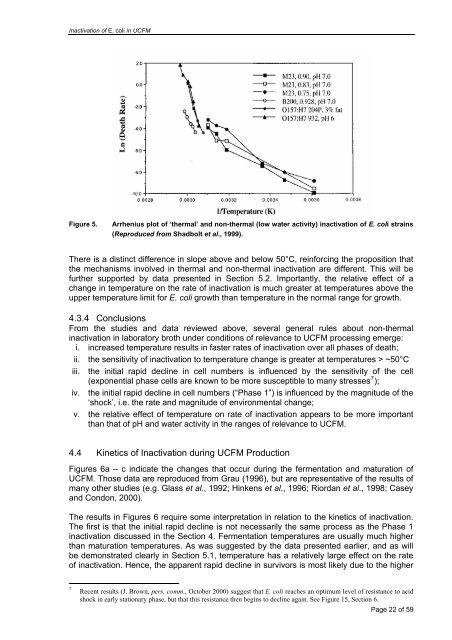Download "Predicting E. coli inactivation in uncooked comminuted ...
Download "Predicting E. coli inactivation in uncooked comminuted ...
Download "Predicting E. coli inactivation in uncooked comminuted ...
You also want an ePaper? Increase the reach of your titles
YUMPU automatically turns print PDFs into web optimized ePapers that Google loves.
Inactivation of E. <strong>coli</strong> <strong>in</strong> UCFMFigure 5.Arrhenius plot of ‘thermal’ and non-thermal (low water activity) <strong><strong>in</strong>activation</strong> of E. <strong>coli</strong> stra<strong>in</strong>s(Reproduced from Shadbolt et al., 1999).There is a dist<strong>in</strong>ct difference <strong>in</strong> slope above and below 50°C, re<strong>in</strong>forc<strong>in</strong>g the proposition thatthe mechanisms <strong>in</strong>volved <strong>in</strong> thermal and non-thermal <strong><strong>in</strong>activation</strong> are different. This will befurther supported by data presented <strong>in</strong> Section 5.2. Importantly, the relative effect of achange <strong>in</strong> temperature on the rate of <strong><strong>in</strong>activation</strong> is much greater at temperatures above theupper temperature limit for E. <strong>coli</strong> growth than temperature <strong>in</strong> the normal range for growth.4.3.4 ConclusionsFrom the studies and data reviewed above, several general rules about non-thermal<strong><strong>in</strong>activation</strong> <strong>in</strong> laboratory broth under conditions of relevance to UCFM process<strong>in</strong>g emerge:i. <strong>in</strong>creased temperature results <strong>in</strong> faster rates of <strong><strong>in</strong>activation</strong> over all phases of death;ii. the sensitivity of <strong><strong>in</strong>activation</strong> to temperature change is greater at temperatures > ~50°Ciii. the <strong>in</strong>itial rapid decl<strong>in</strong>e <strong>in</strong> cell numbers is <strong>in</strong>fluenced by the sensitivity of the cell(exponential phase cells are known to be more susceptible to many stresses 7 );iv. the <strong>in</strong>itial rapid decl<strong>in</strong>e <strong>in</strong> cell numbers (“Phase 1”) is <strong>in</strong>fluenced by the magnitude of the‘shock’, i.e. the rate and magnitude of environmental change;v. the relative effect of temperature on rate of <strong><strong>in</strong>activation</strong> appears to be more importantthan that of pH and water activity <strong>in</strong> the ranges of relevance to UCFM.4.4 K<strong>in</strong>etics of Inactivation dur<strong>in</strong>g UCFM ProductionFigures 6a – c <strong>in</strong>dicate the changes that occur dur<strong>in</strong>g the fermentation and maturation ofUCFM. Those data are reproduced from Grau (1996), but are representative of the results ofmany other studies (e.g. Glass et al., 1992; H<strong>in</strong>kens et al., 1996; Riordan et al., 1998; Caseyand Condon, 2000).The results <strong>in</strong> Figures 6 require some <strong>in</strong>terpretation <strong>in</strong> relation to the k<strong>in</strong>etics of <strong><strong>in</strong>activation</strong>.The first is that the <strong>in</strong>itial rapid decl<strong>in</strong>e is not necessarily the same process as the Phase 1<strong><strong>in</strong>activation</strong> discussed <strong>in</strong> the Section 4. Fermentation temperatures are usually much higherthan maturation temperatures. As was suggested by the data presented earlier, and as willbe demonstrated clearly <strong>in</strong> Section 5.1, temperature has a relatively large effect on the rateof <strong><strong>in</strong>activation</strong>. Hence, the apparent rapid decl<strong>in</strong>e <strong>in</strong> survivors is most likely due to the higher7Recent results (J. Brown, pers. comm., October 2000) suggest that E. <strong>coli</strong> reaches an optimum level of resistance to acidshock <strong>in</strong> early stationary phase, but that this resistance then beg<strong>in</strong>s to decl<strong>in</strong>e aga<strong>in</strong>. See Figure 15, Section 6.Page 22 of 59


